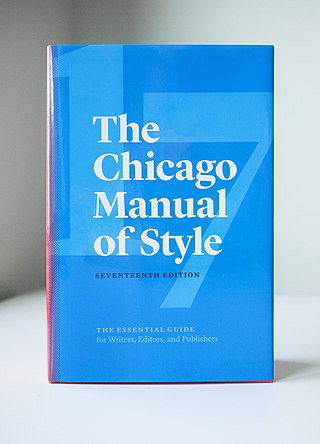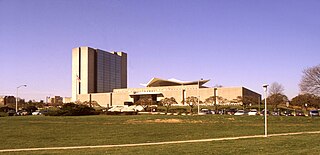Related Research Articles
In computing, AAP DTD is a set of three SGML Document Type Definitions for scientific documents, defined by the Association of American Publishers. It was ratified as a U.S. standard under the name ANSI/NISO Z39.59 in 1988, and evolved into the international ISO 12083 standard in 1993. It was supplanted as a U.S. standard by ANSI/ISO 12083 in 1995.

The Chicago Manual of Style is a style guide for American English published since 1906 by the University of Chicago Press. Its 17 editions have prescribed writing and citation styles widely used in publishing.

A citation is a reference to a source. More precisely, a citation is an abbreviated alphanumeric expression embedded in the body of an intellectual work that denotes an entry in the bibliographic references section of the work for the purpose of acknowledging the relevance of the works of others to the topic of discussion at the spot where the citation appears.
MEDLINE is a bibliographic database of life sciences and biomedical information. It includes bibliographic information for articles from academic journals covering medicine, nursing, pharmacy, dentistry, veterinary medicine, and health care. MEDLINE also covers much of the literature in biology and biochemistry, as well as fields such as molecular evolution.

The United States National Library of Medicine (NLM), operated by the United States federal government, is the world's largest medical library.
ANSEL, the American National Standard for Extended Latin Alphabet Coded Character Set for Bibliographic Use, was a character set used in text encoding. It provided a table of coded values for the representation of characters of the extended Latin alphabet in machine-readable form for thirty-five languages written in the Latin alphabet and for fifty-one romanized languages. ANSEL adds 63 graphic characters to ASCII, including 29 combining diacritic characters.
MARC is a standard set of digital formats for the machine-readable description of items catalogued by libraries, such as books, DVDs, and digital resources. Computerized library catalogs and library management software need to structure their catalog records as per an industry-wide standard, which is MARC, so that bibliographic information can be shared freely between computers. The structure of bibliographic records almost universally follows the MARC standard. Other standards work in conjunction with MARC, for example, Anglo-American Cataloguing Rules (AACR)/Resource Description and Access (RDA) provide guidelines on formulating bibliographic data into the MARC record structure, while the International Standard Bibliographic Description (ISBD) provides guidelines for displaying MARC records in a standard, human-readable form.
A technical report is a document that describes the process, progress, or results of technical or scientific research or the state of a technical or scientific research problem. It might also include recommendations and conclusions of the research. Unlike other scientific literature, such as scientific journals and the proceedings of some academic conferences, technical reports rarely undergo comprehensive independent peer review before publication. They may be considered as grey literature. Where there is a review process, it is often limited to within the originating organization. Similarly, there are no formal publishing procedures for such reports, except where established locally.
The National Information Standards Organization is a United States non-profit standards organization that develops, maintains and publishes technical standards related to publishing, bibliographic and library applications. It was founded in 1939 as the Z39 Committee, incorporated as a not-for-profit education association in 1983, and assumed its current name in 1984.
An OpenURL is similar to a web address, but instead of referring to a physical website, it refers to an article, book, patent, or other resource within a website.
Parenthetical referencing is a citation system in which in-text citations are made using parentheses. They are usually accompanied by a full, alphabetized list of citations in an end section, usually titled "references", "reference list", "works cited", or "end-text citations". Parenthetical referencing can be used in lieu of footnote citations.

The ICMJE recommendations are a set of guidelines produced by the International Committee of Medical Journal Editors for standardising the ethics, preparation and formatting of manuscripts submitted to biomedical journals for publication. Compliance with the ICMJE recommendations is required by most leading biomedical journals. Levels of real compliance are subject to debate. As of 9 January 2020, 5570 journals worldwide claim to follow the ICMJE recommendations.

Colonel Fielding Hudson Garrison, MD was an acclaimed medical historian, bibliographer, and librarian of medicine. Garrison's An Introduction to the History of Medicine (1913) is a landmark text in this field.
The Vancouver system, also known as Vancouver reference style or the author–number system, is a citation style that uses numbers within the text that refer to numbered entries in the reference list. It is popular in the physical sciences and is one of two referencing systems normally used in medicine, the other being the author–date, or "Harvard", system. Vancouver style is used by MEDLINE and PubMed.
Index Medicus (IM) is a curated subset of MEDLINE, which is a bibliographic database of life science and biomedical science information, principally scientific journal articles. From 1879 to 2004, Index Medicus was a comprehensive bibliographic index of such articles in the form of a print index or its onscreen equivalent. Medical history experts have said of Index Medicus that it is “America's greatest contribution to medical knowledge.”
Medical ghostwriters are employed by pharmaceutical companies and medical-device manufacturers to produce apparently independent manuscripts for peer-reviewed journals, conference presentations and other communications. Physicians and other scientists are paid to attach their names to the manuscripts as though they had authored them. The named authors may have had little or no involvement in the research or writing process.
The Grey Literature International Steering Committee (GLISC) was established in 2006 after the 7th International Conference on Grey Literature (GL7) held in Nancy (France) on 5–6 December 2005.

The Journal Article Tag Suite (JATS) is an XML format used to describe scientific literature published online. It is a technical standard developed by the National Information Standards Organization (NISO) and approved by the American National Standards Institute with the code Z39.96-2012.

Conflicts of interest (COIs) often arise in academic publishing. Such conflicts may cause wrongdoing and make it more likely. Ethical standards in academic publishing exist to avoid and deal with conflicts of interest, and the field continues to develop new standards. Standards vary between journals and are unevenly applied. According to the International Committee of Medical Journal Editors, "[a]uthors have a responsibility to evaluate the integrity, history, practices and reputation of the journals to which they submit manuscripts".
References
- ↑ ICMJE, Recommendations for the Conduct, Reporting, Editing, and Publication of Scholarly Work in Medical Journals (PDF).
- ↑ ICMJE, FAQ > ICMJE Recommendations ("The Uniform Requirements").
- ↑ Patrias, Karen, Wendling, Dan (ed.), Citing Medicine: The NLM Style Guide for Authors, Editors, and Publishers, Bethesda, Maryland, US: United States National Library of Medicine.
- ↑ Patrias, Karen, "Introduction", in Wendling, Dan (ed.), Citing Medicine: The NLM Style Guide for Authors, Editors, and Publishers, Bethesda, Maryland: United States National Library of Medicine.